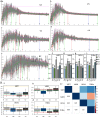QTL detection for bread wheat processing quality in a nested association mapping population of semi-wild and domesticated wheat varieties
- PMID: 35313801
- PMCID: PMC8935700
- DOI: 10.1186/s12870-022-03523-x
QTL detection for bread wheat processing quality in a nested association mapping population of semi-wild and domesticated wheat varieties
Abstract
Background: Wheat processing quality is an important factor in evaluating overall wheat quality, and dough characteristics are important when assessing the processing quality of wheat. As a notable germplasm resource, semi-wild wheat has a key role in the study of wheat processing quality.
Results: In this study, four dough rheological characteristics were collected in four environments using a nested association mapping (NAM) population consisting of semi-wild and domesticated wheat varieties to identify quantitative trait loci (QTL) for wheat processing quality. A total of 49 QTL for wheat processing quality were detected, explaining 0.36-10.82% of the phenotypic variation. These QTL were located on all wheat chromosomes except for 2D, 3A, 3D, 6B, 6D and 7D. Compared to previous studies, 29 QTL were newly identified. Four novel QTL, QMlPH-1B.4, QMlPH-3B.4, QWdEm-1B.2 and QWdEm-3B.2, were stably identified in three or more environments, among which QMlPH-3B.4 was a major QTL. Moreover, eight important genetic regions for wheat processing quality were identified on chromosomes 1B, 3B and 4D, which showed pleiotropy for dough characteristics. In addition, out of 49 QTL, 15 favorable alleles came from three semi-wild parents, suggesting that the QTL alleles provided by the semi-wild parent were not utilized in domesticated varieties.
Conclusions: The results show that semi-wild wheat varieties can enrich the existing wheat gene pool and provide broader variation resources for wheat genetic research.
Keywords: Nested association mapping (NAM) population; Processing quality; Quantitative trait locus; Semi-wild wheat; Wheat.
© 2022. The Author(s).
Conflict of interest statement
The authors declare that they have no competing interests.
Figures


References
-
- Brenchley R, Spannagl M, Pfeifer M, Barker GLA, D’Amore R, Allen AM, McKenzie N, Kramer M, Kerhornou A, Bolser D, Kay S, Waite D, Trick M, Bancroft I, Gu Y, Huo N, Luo MC, Sehgal S, Gill B, Kianian S, Anderson O, et al. Analysis of the bread wheat genome using whole-genome shotgun sequencing. Nature. 2012;491:705–710. - PMC - PubMed
-
- Mann G, Diffey S, Cullis B, Azanza F, Martin D, Kelly A, McIntyre L, Schmidt A, Ma WJ, Nath Z, Kutty I, Leyne PE, Rampling L, Quail KJ, Morell MK. Genetic control of wheat quality: interactions between chromosomal regions determining protein content and composition, dough rheology, and sponge and dough baking properties. Theor Appl Genet. 2009;118:1519–1537. - PubMed
-
- Payne PI, Holt LM, Worland AJ, Law CN. Structural and genetical studies on the high-molecular-weight subunits of wheat glutenin. Theor Appl Genet. 1982;63:129–138. - PubMed
Publication types
MeSH terms
LinkOut - more resources
Full Text Sources
Research Materials

